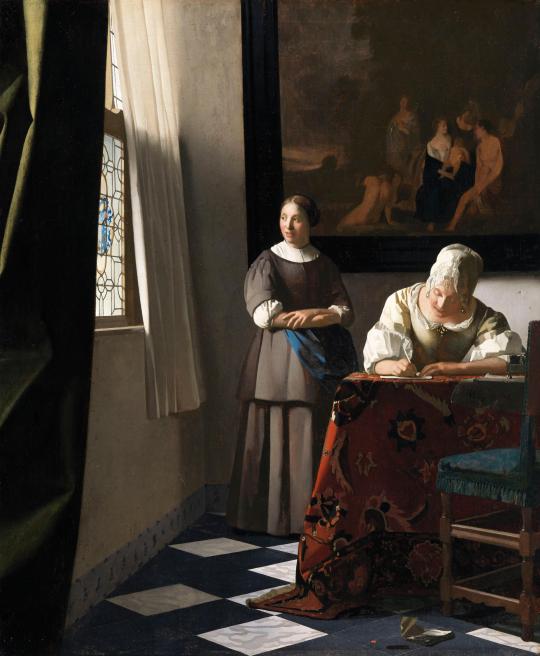#Johannes Vermeer
Explore tagged Tumblr posts
Text

Johannes Vermeer, Woman Writing a Letter, ca. 1670-1671, oil/canvas (National Gallery of Ireland, Dublin)
538 notes
·
View notes
Text
Artist aravisdolmenna
Some images have been repeated so many times that even a hint can conjure them, I don’t know what it is about the half smile that keeps people fascinated or about one pearl earring that identifies one portrait out of a sea of long dead faces, unfortunately though, even if “imitation is the sincerest form of flattery” it will take more than a pearl to make a masterpiece from my morning egg.

141 notes
·
View notes
Text

The Astronomer by Johannes Vermeer
#johannes vermeer#art#astronomer#astronomy#dutch golden age#europe#european#netherlands#holland#room#globe#globes
437 notes
·
View notes
Text

Black Girl With a Pearl, 2018
Photographer: Jenny Boot
Model: Norah Namuddu
@Jennyboot_photography, a take on Johannes Vermeer’s Girl With a Pearl Earring.
#reddit#pics#nastynice1#jenny boots#inspiration#jenny boot#johannes vermeer#girl with a pearl earring#2018#2010s#art#photographer#photography#my girl with a pearl#@jennyboot_photography#black girl with a pearl#Norah Namuddu#blm#black history month#womens history#womens history month#whm#woman#women
979 notes
·
View notes
Text

Johannes Vermeer
#johannes vermeer#jan vermeer#art#artwork#fine art#fineart#painting#art history#history of art#women in art
361 notes
·
View notes
Text
When your Character is Sleep Deprived

Sleep Deprivation - occurs when you don’t routinely get sufficient sleep at night.
Seven to eight hours of quality sleep time is the baseline for most adults, yet the Centers for Disease Control and Prevention (CDC) estimates that one third of American adults suffer from measurable sleep loss.
This lack of sleep can lead to disruptions in everyday life, from grogginess and delayed reaction times to serious medical conditions.
Causes of Sleep Deprivation
Many factors can prevent you from getting a good night's sleep. These include:
Sleep disorders: Certain conditions like sleep apnea and restless leg syndrome can interfere with healthy sleep.
Mental health conditions: Depression and anxiety can be sources of severe sleep deprivation.
External stimuli: Loud noises, bright lights, and hot temperatures can all prevent you from getting enough sleep.
Work schedules: Shift work at night can clash with your natural circadian rhythms and trigger sleep deprivation.
Physical activity: Exercise can inhibit sleep onset if scheduled too close to bedtime.
Effects of Sleep Deprivation
The consequences of sleep deprivation can be serious. A person operating on insufficient sleep may face increased risk of the following effects.
Daytime drowsiness: A poorly rested person can go through the day feeling groggy. This can lead to drowsy driving, car accidents, mental slip-ups, and poor cognition.
Microsleep: In addition to general drowsiness, a person running on very little sleep can experience microsleep—very short bursts of unconsciousness that feel like blacking out.
Mood swings: A person overcome by sleepiness may be cranky and irritable, and they may also experience headaches that further sour their mood.
Memory issues: Poor sleep patterns that cause a person to get less sleep have the potential to affect memory recall.
Tips for Avoiding Sleep Deprivation
To ensure you get consistent and sufficient sleep duration, consider the following strategies.
Stick to a bedtime routine. Sleep difficulties can stem from inconsistent schedules and routines. Improve your sleep hygiene by creating consistent sleep habits and a bedtime routine. This may involve stretching, an evening shower, or a cup of tea.
Avoid digital screens before bed. The blue light of electronics can mimic the effects of sunlight and prevent your body from entering its natural sleep cycle. Keep digital devices out of the bedroom, and when you must use them before bed, use a blue light filter that keeps the most disruptive light out of your eyes.
Consider a natural sleep remedy. Supplemental melatonin can help you fall asleep when your routine sleep schedule has been disrupted. Take care to not build reliance on sleep medications that may dampen the restorative effects of REM sleep and non-REM sleep.
Lower the temperature of your bedroom. A nighttime room temperature of 60 to 67 degrees Fahrenheit signals to your brain that it’s time to sleep.
Practice mindful relaxation techniques. A bedtime ritual of deep breathing exercises and slow exhales can promote progressive muscle relaxation. Mindfulness can also eliminate tension while allowing your body to drift into drowsiness and get enough hours of sleep.
Monitor your health conditions. Certain medical conditions, like sleep apnea and restless leg syndrome, can impair sleep onset and deprive you of sleep over the course of the night. Seek medical advice for handling such conditions, and work with your healthcare provider to develop treatment and coping strategies.
Source ⚜ More: Notes & References ⚜ Writing Resources PDFs
#sleep#sleep deprivation#writing reference#writeblr#character development#writing notes#literature#writers on tumblr#dark academia#spilled ink#writing prompt#creative writing#light academia#writing inspiration#writing ideas#johannes vermeer#writing resources
492 notes
·
View notes
Text

pearl with a pearl earring - a redraw
#rat noises#steven universe#su#su pearl#pearl#su fanart#digital art#girl with a pearl earring#johannes vermeer#digital painting#historical gems
552 notes
·
View notes
Text

ASCII explorations by Enigmatriz.
169 notes
·
View notes
Text

The Milkmaid by Johannes Vermeer, 1658.
#classic art#painting#johannes vermeer#dutch artist#17th century#baroque#dutch golden age#genre art#woman#workers#servants#tableware#milk#basket#food#bread#inside
321 notes
·
View notes
Text

Girl Interrupted at Her Music, Johannes Vermeer, circa 1658-59
Oil on canvas 15 ½ x 17 ½ in. (39.4 x 44.5 cm) The Frick Collection, New York City, NY, USA
#art#painting#johannes vermeer#baroque#baroque art#17th century art#17th century#1650s#dutch golden age#dutch#oil#the frick#genre scene#100 notes
127 notes
·
View notes
Text

Girl with pearl earring, ca. 1665, Mauritshuis, Netherlands, Johannes Vermeer (Dutch, 1632 - 1675) - unknown photographer
971 notes
·
View notes
Text

The Milkmaid
Johannes Vermeer
oil on canvas, ca.1658 to 1661
125 notes
·
View notes
Text

Johannes Vermeer, Woman Reading a Letter, 1663
at Rijksmuseum Amsterdam, Amsterdam
105 notes
·
View notes
Text

Johannes Vermeer
#johannes vermeer#jan vermeer#art#artwork#fine art#fineart#painting#art history#history of art#women in art
261 notes
·
View notes
Text
Writing Notes: Detective Story

References (Elements; Subgenres; Tips; Some Vocabulary)
Detective story - one whose plot hinges on a crime that the characters investigate and attempt to solve.
Also called “whodunnit” stories or crime stories.
Most detective stories are written from the point of view of a detective.
5 Basic Elements
A Detective
Usually featured as the protagonist.
Spend time thinking about your detective’s personality, their motivations, their background, their strengths, and their weaknesses. You’ll want your detective to be unique among the other detectives out there.
A Crime
Most detective stories revolve around a central crime or string of related crimes.
Since the crime will be the catalyst of your short story or novel, it should be interesting, memorable, and seemingly unsolvable—that way, readers will be so tantalized by the mystery of it that they’ll need to keep reading.
A dead body is a very common crime in detective fiction, but there are plenty of other options—from robberies to disappearances.
Suspects
Many detective stories include an array of suspects that could have committed the crime (either they have weak alibis or have a history of lying).
Your suspects are a vital part of your detective story; they serve as red herrings (or distractions) that will direct readers’ attention away from the true culprit.
Some mystery novels don’t have any suspects—this is a deliberate choice by crime writers that serves to heighten the tension in the story, but if your story doesn’t have any suspects, find creative ways to keep the case from going cold.
An Antagonist
The person whose goals are in direct conflict with the antagonist’s.
Traditionally, the antagonist is the true culprit for the story’s crime (or crimes), but that’s not who your antagonist has to be; the antagonist of your story could be a police officer who wants to solve the crime first or someone who knows the identity of the culprit and is trying to cover it up.
A Setting
The setting is a very important part of any detective story because the action in most detective stories takes place on the streets of its location.
Therefore the stories are inextricably linked to the time and place they are set in and are memorable because of those details.
5 Subgenres
Here are just a few subgenres that fall under detective stories
Police-department procedurals. Focus on police work and often feature homicide investigators and other departments of a local police force.
Cozy mysteries. These have a lighter tone than traditional detective fiction and avoid explicit depictions of the murder. They are often set in a small town and focus on puzzle-solving rather than suspense.
Hardboiled detective stories. These stories are usually dark and explicit, featuring a veteran detective who treats violent crimes matter-of-factly.
Thrillers. Emphasize suspenseful storytelling, often featuring chase scenes or murder sprees that the detective must stop before the time runs out.
Locked-room mysteries. Feature crimes that, at the outset, appear impossible—for instance, a murder taking place in a seemingly locked room with no other way in or out.
5 Tips for Writing a Good Detective Story
Interesting Motivation
The motivation of the culprit is one of the most crucial and prominent parts of detective work—what readers want to know even more than who committed the crime is why they committed it.
Nothing spoils a good detective story more than an uninteresting or unbelievable motivation (for instance, a serial killer who is just “pure evil” and has no discernable reasons for murdering) or an unmotivated confession.
In the same vein, your detective should also have a strong motivation for being in this line of work—it’s not easy, and many people wouldn’t be able to stomach it.
Learn about Detective Work
Readers want to feel immersed in the world of your detective story—whether it’s the world of the law or the seedy underbelly of a small town.
That’s why it’s so important to get the details right when crime writing—so you can keep the reader’s attention with believable plot points.
Do the research to make sure that you know who would be the first to make it to the scene of a crime, how detectives would go about tracking people down or questioning them, and what role forensics would play in your crime scene, so that your readers don’t spend any time wondering if what they’re reading is accurate to real life.
Too Easy
Readers pick up detective fiction because they want to be intrigued by a good mystery—so if your crime is too easy for them to solve, they’ll get bored and likely not finish the story.
Trust in your readers’ ability for logical deduction and don’t give too much away, leaving them guessing and really shocking them.
A Payoff
Try to avoid an outcome where readers will feel let down by the answer.
In the words of S. S. Van Dine, a famous mystery-novel-writing art critic, “A crime in a detective story must never turn out to be an accident or a suicide. To end an odyssey of sleuthing with such an anti-climax is to hoodwink the trusting and kind-hearted reader.”
By that same logic, try to avoid any “deus ex machina”— an impossible-to-solve situation is suddenly resolved with little or no effort from the characters.
Experiment & Innovate
Read lots of detective fiction and then subvert the tropes—
What if your main character is the person who committed the crime, and your bad guy is the detective or official investigator working to solve it?
Or what if your character’s love interest was the victim?
Common Terms in Detective Fiction
Establish a working vocabulary will help improve detective fiction writing
accusation - statement that places blame on a specific person or persons
alias - an alternate name used to conceal identity
alibi - an explanation that removes a person from the scene of a crime when it occurred
angle - specific strategy or way of looking at facts as employed by the detective during an investigation
autopsy - the medical examination of a corpse to determine cause(s) of death
booking - the process whereby a suspect is officially arrested and charged with a crime
case - the investigation of a crime from the time it is reported/ discovered until it is resolved (closed)
charges - specific crime(s) a person is accused of
circumstantial - indicative but not conclusive
clue - anything that sheds light on a particular case
collar - the actual arrest by a police officer
corpus dilecti - the actual body that proves a murder has been committed
crime of passion - a crime committed in a rage of anger, hatred, revenge, etc.
culprit - the “bad guy;” criminal
D.A. - district attorney; works for the government
deduction - conclusion reached through a logical progression of steps
defense - the argument made to show the innocence of the accused person
evidence - material that will prove innocence or guilt
eyewitness - someone who actually observes a crime and/or criminal
felony - major crime (i.e., armed robbery, murder, rape)
foil - the detective’s “right hand man;” he/she is usually quite different in nature. Ex: Holmes/Watson; Nero Wolfe/ Archie Goodwin
frame-up - deliberate trap set to lay blame on an innocent person
habeas corpus - accusor has to produce a body in order to hold a suspect
homicide - the act of murder
hunch - guess; instinct
informer - relays information to police/detective for money (usually)
inquest/inquiry - legal questioning concerning a particular event or action
lead - something/someone that may help move an investigation to a solution
malice aforethought - criminal was already considering a hostile act before the crime occurred
manslaughter - accidental killing
misdemeanor - minor offense
modus operandi - method of operation (m.o.) that a criminal employs during his crimes
morgue - city government building where dead bodies are kept during investigations
motive - reason for committing a crime
perpetrator - offender; criminal
post mortem - the report from an autopsy
premeditation - deliberate intent to perform a crime before it occurs
private eye - private detective
prosecutor - attorney working for the District Attorney; person trying to prove guilt in a courtroom
red herring - a false clue that usually misleads the reader (and often the detective)
set-up - a trap that is designed to catch a criminal or victim
sleuth - detective
statement - official document containing information supplied by witness, suspect, or any other person involved in an investigation
stool pigeon - informer
surveillance - constant visual or electronic monitoring of a person’s activities
suspect - someone who may have reason to have committed a specific crime
tank - jail cell
third degree - intensive questioning of a suspect
victim - person who is hurt or killed as a result of a criminal act
Sources: 1 2 Writing Notes: Autopsy ⚜ Word Lists: Forensics ⚜ Law-Related
#detective#writing reference#writeblr#dark academia#writers on tumblr#spilled ink#fiction#mystery#novel#creative writing#literature#terminology#writing prompt#light academia#writing tips#writing advice#writing inspiration#johannes vermeer#writing ideas#crime fiction#writing resources
242 notes
·
View notes
